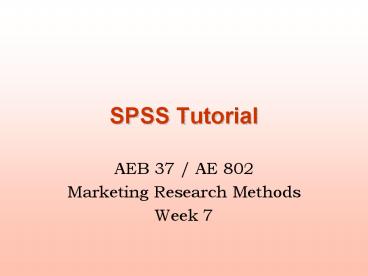SPSS Tutorial - PowerPoint PPT Presentation
1 / 42
Title:
SPSS Tutorial
Description:
Elbow rule (2): the scree diagram. Validating the analysis ... The scree diagram (Excel needed) Number of clusters. Number of cases 150. Step of elbow' 144 ... – PowerPoint PPT presentation
Number of Views:1681
Avg rating:3.0/5.0
Title: SPSS Tutorial
1
SPSS Tutorial
- AEB 37 / AE 802
- Marketing Research Methods
- Week 7
2
Cluster analysis
- Lecture / Tutorial outline
- Cluster analysis
- Example of cluster analysis
- Work on the assignment
3
Cluster Analysis
- It is a class of techniques used to classify
cases into groups that are relatively homogeneous
within themselves and heterogeneous between each
other, on the basis of a defined set of
variables. These groups are called clusters.
4
Cluster Analysis and marketing research
- Market segmentation. E.g. clustering of consumers
according to their attribute preferences - Understanding buyers behaviours. Consumers with
similar behaviours/characteristics are clustered - Identifying new product opportunities. Clusters
of similar brands/products can help identifying
competitors / market opportunities - Reducing data. E.g. in preference mapping
5
Steps to conduct a Cluster Analysis
- Select a distance measure
- Select a clustering algorithm
- Determine the number of clusters
- Validate the analysis
6
(No Transcript)
7
Defining distance the Euclidean distance
- Dij distance between cases i and j
- xki value of variable Xk for case j
- Problems
- Different measures different weights
- Correlation between variables (double counting)
- Solution Principal component analysis
8
Clustering procedures
- Hierarchical procedures
- Agglomerative (start from n clusters, to get to 1
cluster) - Divisive (start from 1 cluster, to get to n
cluster) - Non hierarchical procedures
- K-means clustering
9
Agglomerative clustering
10
Agglomerative clustering
- Linkage methods
- Single linkage (minimum distance)
- Complete linkage (maximum distance)
- Average linkage
- Wards method
- Compute sum of squared distances within clusters
- Aggregate clusters with the minimum increase in
the overall sum of squares - Centroid method
- The distance between two clusters is defined as
the difference between the centroids (cluster
averages)
11
K-means clustering
- The number k of cluster is fixed
- An initial set of k seeds (aggregation centres)
is provided - First k elements
- Other seeds
- Given a certain treshold, all units are assigned
to the nearest cluster seed - New seeds are computed
- Go back to step 3 until no reclassification is
necessary - Units can be reassigned in successive steps
(optimising partioning)
12
Hierarchical vs Non hierarchical methods
- Hierarchical clustering
- No decision about the number of clusters
- Problems when data contain a high level of error
- Can be very slow
- Initial decision are more influential (one-step
only)
- Non hierarchical clustering
- Faster, more reliable
- Need to specify the number of clusters
(arbitrary) - Need to set the initial seeds (arbitrary)
13
Suggested approach
- First perform a hierarchical method to define the
number of clusters - Then use the k-means procedure to actually form
the clusters
14
Defining the number of clusters elbow rule (1)
n
15
Elbow rule (2) the scree diagram
16
Validating the analysis
- Impact of initial seeds / order of cases
- Impact of the selected method
- Consider the relevance of the chosen set of
variables
17
SPSS Example
18
(No Transcript)
19
Number of clusters 10 6 4
20
(No Transcript)
21
Open the dataset supermarkets.sav
- From your N directory (if you saved it there
last time - Or download it from http//www.rdg.ac.uk/aes02mm
/supermarket.sav - Open it in SPSS
22
The supermarkets.sav dataset
23
Run Principal Components Analysis and save scores
- Select the variables to perform the analysis
- Set the rule to extract principal components
- Give instruction to save the principal components
as new variables
24
Cluster analysis basic steps
- Apply Wards methods on the principal components
score - Check the agglomeration schedule
- Decide the number of clusters
- Apply the k-means method
25
Analyse / Classify
26
Select the component scores
Untick this
Select from here
27
Select Wards algorithm
Select method here
Click here first
28
Output Agglomeration schedule
29
Number of clusters
Identify the step where the distance
coefficients makes a bigger jump
30
The scree diagram (Excel needed)
31
Number of clusters
- Number of cases 150
- Step of elbow 144
- __________________________________
- Number of clusters 6
32
Now repeat the analysis
- Choose the k-means technique
- Set 6 as the number of clusters
- Save cluster number for each case
- Run the analysis
33
K-means
34
K-means dialog box
Specify number of clusters
35
Save cluster membership
Click here first
Thick here
36
Final output
37
Cluster membership
38
Component meaning(tutorial week 5)
4. Organic radio listener
1. Old Rich Big Spender
3. Vegetarian TV lover
2. Family shopper
5. Vegetarian TV and web hater
39
(No Transcript)
40
Cluster interpretation through mean component
values
- Cluster 1 is very far from profile 1 (-1.34) and
more similar to profile 2 (0.38) - Cluster 2 is very far from profile 5 (-0.93) and
not particularly similar to any profile - Cluster 3 is extremely similar to profiles 3 and
5 and very far from profile 2 - Cluster 4 is similar to profiles 2 and 4
- Cluster 5 is very similar to profile 3 and very
far from profile 4 - Cluster 6 is very similar to profile 5 and very
far from profile 3
41
Which cluster to target?
- Objective target the organic consumer
- Which is the cluster that looks more organic?
- Compute the descriptive statistics on the
original variables for that cluster
42
Representation of factors 1 and 4(and cluster
membership)































